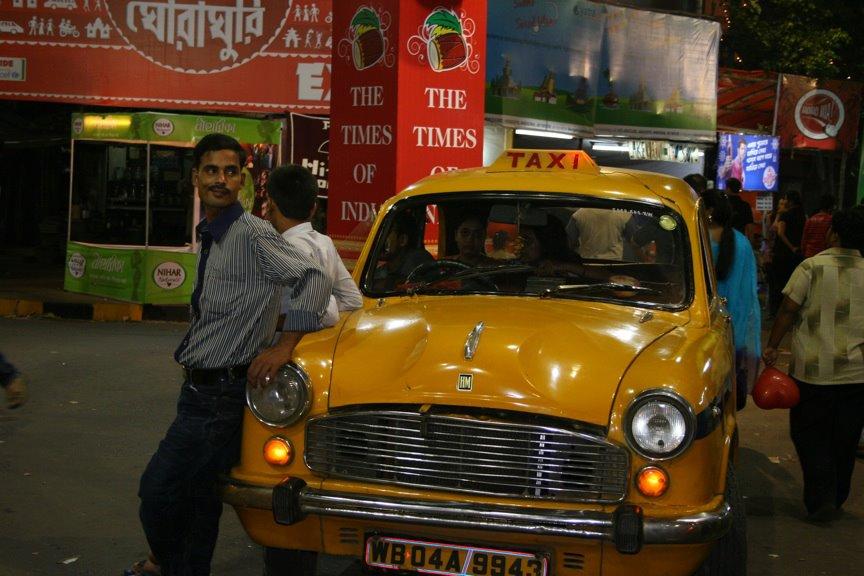Forget the Ford Mustang, the Hindustan Ambassador is the only car to truly embody a country
An Ambassador taxi waits outside a busy festival in Kolkata, India.
Picture a really old Volvo, with its softer, rounder edges. You know, before the company went all boxy.
Those soft curves give you an idea of what an Ambassador looks like. We're talking about the first car ever manufactured in India.
It became the country's iconic automobile, changing very little in more than six decades on the road.
Well, last week, the Ambassador hit a milestone, or actually, a gravestone. Its maker, Hindustan Motors, halted production.
The Amby, as fans call it, was long the vehicle of choice for Indian politicians … who rode around in fancy white ones. It’s also the choice for taxi drivers, who continue to drive bright yellow ones. It's also the car of choice for Siddharth Varadarajan, former editor of The Hindu newspaper in Delhi. He owns three.
“The oldest model I have is from 1952,” he says. “Back in the day, it used to be called ‘Hindustan 14.’”
He also owns a model from 1954 known as the ‘landmaster.’ His most current model is from 2006. That’s the one most people are familiar with. His collection represents three models with three different designs. “But one great tradition,” he adds.
It's hard to come up with a US analogy. The Ford Mustang is iconic, but it’s an iconic muscle car. The Crown Victoria was close. But it was never omnipresent like the Ambassador was in India. The car embodies both a cultural and historic place. It’s tied up in India’s colonial history. Designers based the model off the British Morris Oxford III. But it’s an Indian car. Varadarajan says it harkens back to Indian independence, the years of great optimism and hope, years of great vision of where the country must head. He adds it also shows the flaws in such a pursuit, as the Ambassador inhaled fuel, giving it poor gas mileage.
“It represented the hopes and aspirations and visions of a country, warts and all,” he says.
Varadarajan says the halting of production is tragic. He's biased, of course. But he points to the flood of newer, cheaper cars on the market as one of the reasons for its demise. He still hopes the factory will somehow revive the car and return it to its iconic hope. He’s knows it’s probably not in the cards. But he’s a car lover. And such a hope is probably keeping his spirits up.
You can still see Varadarajan driving his cars through the streets of New Delhi. He loves the way they drive. His older ones attract stares the way classic car do. And there’s no chance he’ll be parting with any of them. He plans to hang on to his Ambassadors for as long as he’s around.
“And beyond.”
Picture a really old Volvo, with its softer, rounder edges. You know, before the company went all boxy.
Those soft curves give you an idea of what an Ambassador looks like. We're talking about the first car ever manufactured in India.
It became the country's iconic automobile, changing very little in more than six decades on the road.
Well, last week, the Ambassador hit a milestone, or actually, a gravestone. Its maker, Hindustan Motors, halted production.
The Amby, as fans call it, was long the vehicle of choice for Indian politicians … who rode around in fancy white ones. It’s also the choice for taxi drivers, who continue to drive bright yellow ones. It's also the car of choice for Siddharth Varadarajan, former editor of The Hindu newspaper in Delhi. He owns three.
“The oldest model I have is from 1952,” he says. “Back in the day, it used to be called ‘Hindustan 14.’”
He also owns a model from 1954 known as the ‘landmaster.’ His most current model is from 2006. That’s the one most people are familiar with. His collection represents three models with three different designs. “But one great tradition,” he adds.
It's hard to come up with a US analogy. The Ford Mustang is iconic, but it’s an iconic muscle car. The Crown Victoria was close. But it was never omnipresent like the Ambassador was in India. The car embodies both a cultural and historic place. It’s tied up in India’s colonial history. Designers based the model off the British Morris Oxford III. But it’s an Indian car. Varadarajan says it harkens back to Indian independence, the years of great optimism and hope, years of great vision of where the country must head. He adds it also shows the flaws in such a pursuit, as the Ambassador inhaled fuel, giving it poor gas mileage.
“It represented the hopes and aspirations and visions of a country, warts and all,” he says.
Varadarajan says the halting of production is tragic. He's biased, of course. But he points to the flood of newer, cheaper cars on the market as one of the reasons for its demise. He still hopes the factory will somehow revive the car and return it to its iconic hope. He’s knows it’s probably not in the cards. But he’s a car lover. And such a hope is probably keeping his spirits up.
You can still see Varadarajan driving his cars through the streets of New Delhi. He loves the way they drive. His older ones attract stares the way classic car do. And there’s no chance he’ll be parting with any of them. He plans to hang on to his Ambassadors for as long as he’s around.
“And beyond.”
